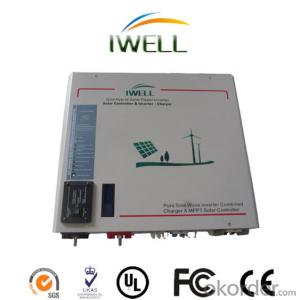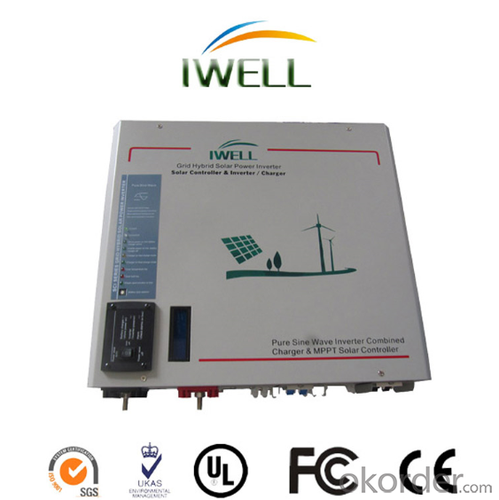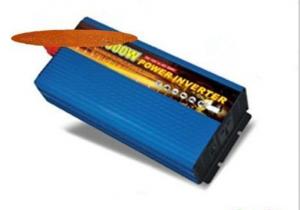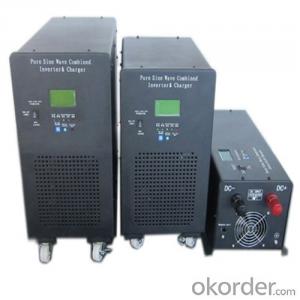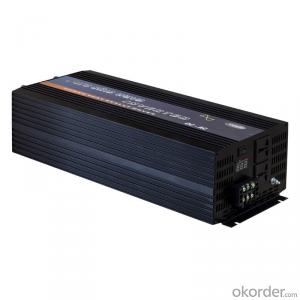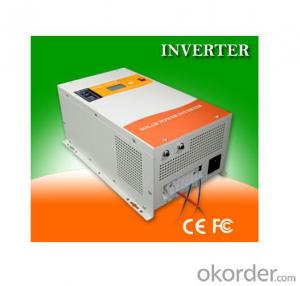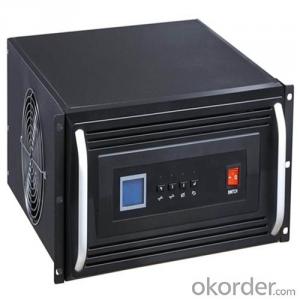400V Solar Inverter 12V 24V 1-3KW Pure Sine Wave Inverter with Controller and Charger
- Loading Port:
- Qingdao
- Payment Terms:
- TT or LC
- Min Order Qty:
- 50 unit
- Supply Capability:
- 3000 unit/month
OKorder Service Pledge
OKorder Financial Service
You Might Also Like
1. Structure of Solar System 12V 24V 1-3KW Inverter with Controller and Charger Pure Sine Wave
A solar inverter, or PV inverter, or Solar converter, converts the variable direct current (DC) output of a photovoltaic (PV) solar panel into a utility frequency alternating current (AC) that can be fed into a commercial electrical grid or used by a local, off-grid electrical network.
It is a critical BOS–component in a photovoltaic system, allowing the use of ordinary AC-powered equipment.
Solar inverters have special functions adapted for use with photovoltaic arrays, including maximum power point tracking and anti-islanding protection.
2. Main Features of the Solar System 12V 24V 1-3KW Inverter with Controller and Charger Pure Sine Wave
﹒Output waveform: pure sine wave
﹒High efficiency>85%
﹒12v or24v or 48vDC input
﹒AC100V or AC110V or AC120V/220v /230V /240V AC output
﹒Output frequency 60HZ or 50HZ
﹒Continuous output power:10KW
﹒High-velocity cooling fan
﹒Overload protect ,over voltage protect ,low voltage cut-out ,low voltage alarm
3. Solar System 12V 24V 1-3KW Inverter with Controller and Charger Pure Sine Wave Images
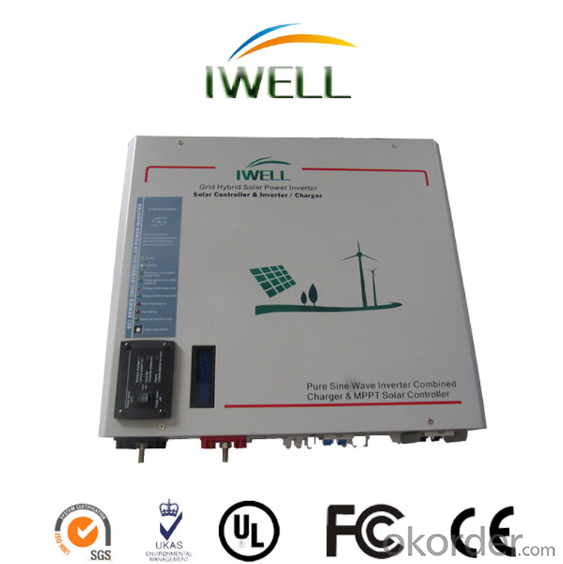

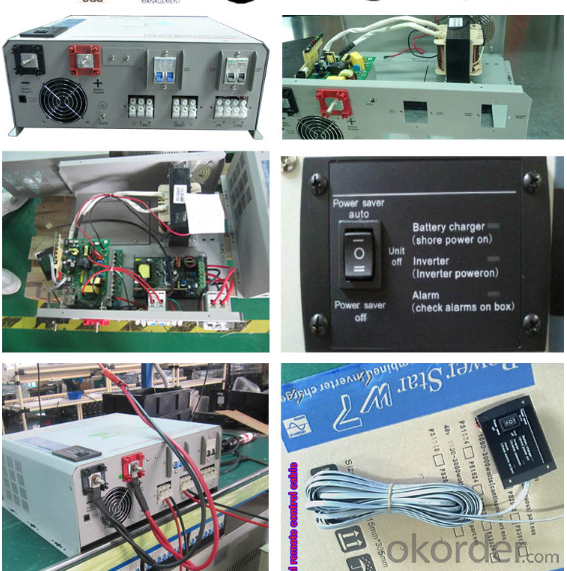
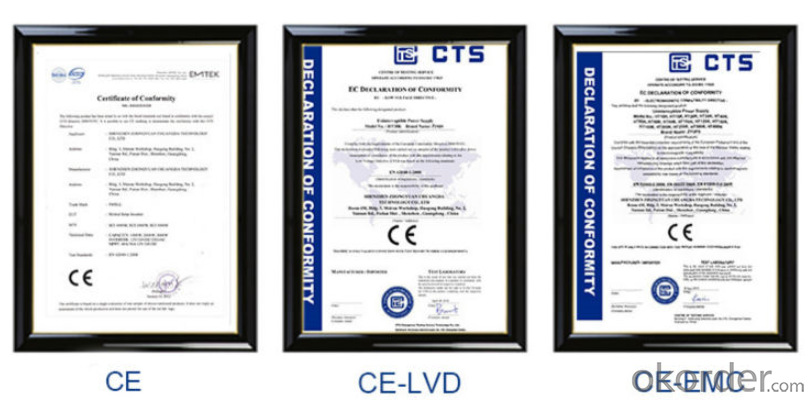

4. Solar System 12V 24V 1-3KW Inverter with Controller and Charger Pure Sine Wave Specification
Mode | PTV 500W | PTV 1000W | PTV 1500W | PTV 2000 | PTV 3000 |
Continuous power (W) | 500W | 1000W | 1500W | 2000W | 3000W |
Surge capability (W) | 1500W | 3000W | 4500W | 6000W | 6000W |
System DC input (VDC) | 12VDC | 24VDCV | 24VDC | 24VDC | 24VDC |
AC Output | 110 / 120V/ 220V/230V ±5% , 50HZ or 60HZ. Terminal | ||||
AC Output waveform | Pure Sine Wave | ||||
DC output | 12VDC or 24VDC Terminal | ||||
Efficiency | 88% | ||||
AC/DC Charger | Max 15A | Max 25A | Max 25A | Max 40AMP | Max 50 |
Solar Charge Controller | MPPT,20AMP | MPPT,30AMP | MPPT,40AMP | MPPT,50AMP | MPPT 100AMP |
Adviced PV | 36 or 72 Cell | 72 Cell | 72 Cell | 72 Cell | 72 Cell |
External battery back | 12 or 24VDC | 24VDC | 24VDC | 24VDC | 24VDC |
Breakers | with Breakers for AC Input , AC output, PV input , DC output | ||||
Battery low protection | yes | ||||
Over discharge protection | yes | ||||
Resume voltage | yes. When fault remove | ||||
Over voltage protection | yes | ||||
Overload protection | yes. | ||||
With cooling fan | yes | ||||
Display | LED for Inverter,charger,Battery Capacity state, DC load state and fault. LCD display is optional | ||||
Running Temperature | -35 degree to 55 degree | ||||
High temperature protection | YES | ||||
Short circuit protection | YES | ||||
Reverse polarity protection | YES. Only for DC load side. | ||||
Stand by | yes. continou ouput while > 25W | ||||
Communication | RS232 Power Manager, NetAgent SNMP , Optional for LED mode | ||||
Package Size(mm) | 608*558*293 | 608*558*293 | 608*558*293 | 608*558*293 | 608*558*293 |
Gross Weight KG | 21 | 24 | 24 | 26 | 32 |
product Size (mm) | 460*440*200 | 460*440*200 | 460*440*200 | 460*440*200 | 460*440*200 |
product weight( kg) | 15KG | 16KG | 16KG | 19.5KG | 24KG |
5. FAQ of Solar System 12V 24V 1-3KW Inverter with Controller and Charger Pure Sine Wave
Q1. What is the difference between inverter and solar inverter?
A1. Inverter only has AC inpput, but solar inverter both connect to AC input and solar panel, it saves more power.
Q2. What is the difference between MPPT&PWM?
A2. MPPT has higher efficiency, it can track the max power point and won't waste energy.
Q3. What is the waranty of product?
A3. 12 months.
- Q: Can a solar inverter be used with a solar-powered air conditioner?
- Yes, a solar inverter can be used with a solar-powered air conditioner. The solar inverter is responsible for converting the direct current (DC) produced by the solar panels into alternating current (AC) that can be used to power electrical appliances, including air conditioners. By connecting the solar inverter to the solar panels and then to the solar-powered air conditioner, the AC produced by the inverter can be utilized to run the air conditioner, effectively making it solar-powered.
- Q: How does a solar inverter impact the payback period of a solar system?
- A solar inverter plays a crucial role in the payback period of a solar system. It converts the direct current (DC) electricity generated by solar panels into alternating current (AC) electricity that is usable for homes or businesses. A high-quality solar inverter ensures maximum energy efficiency, allowing the solar system to generate and utilize more electricity effectively. By optimizing energy production, a solar inverter can significantly reduce the payback period of a solar system, allowing users to recoup their initial investment and start saving on electricity bills more quickly.
- Q: Can a solar inverter be upgraded or expanded in the future?
- Yes, a solar inverter can be upgraded or expanded in the future. Inverter technology is constantly evolving, and manufacturers often release firmware updates or offer hardware upgrades to improve performance, add new features, or increase capacity. Additionally, in case of increased energy demands or the addition of more solar panels, it is possible to expand the system's capacity by adding additional inverters or upgrading the existing inverter to a higher capacity model.
- Q: Can a solar inverter be used with a solar-powered healthcare system?
- Yes, a solar inverter can be used with a solar-powered healthcare system. A solar inverter is responsible for converting the direct current (DC) generated by the solar panels into alternating current (AC) that can be used to power electrical equipment. Therefore, it is an essential component in any solar-powered system, including healthcare systems, to ensure the efficient and reliable operation of medical equipment.
- Q: Can a solar inverter be used in harsh environmental conditions?
- Yes, solar inverters are designed to withstand harsh environmental conditions such as extreme temperatures, high humidity, and exposure to dust, dirt, and corrosive elements. They are built with robust materials and undergo rigorous testing to ensure their durability and reliability in challenging environments. Additionally, some solar inverters come with IP65 or higher ratings, indicating their resistance to water and dust ingress, making them suitable for installation in outdoor and harsh conditions.
- Q: What is the role of a solar inverter in net metering?
- The role of a solar inverter in net metering is to convert the direct current (DC) electricity generated by the solar panels into alternating current (AC) electricity that can be used by the utility grid. It also ensures that any excess electricity generated by the solar panels is fed back into the grid, allowing the consumer to receive credits for the surplus energy produced.
- Q: Can a solar inverter be used in a community solar project?
- Yes, a solar inverter can be used in a community solar project. A solar inverter is an essential component that converts the direct current (DC) generated by solar panels into alternating current (AC) for use in homes and businesses. In a community solar project, multiple participants can benefit from a shared solar installation, and each participant can have their own solar inverter to convert the DC energy into usable AC power.
- Q: How does a solar inverter interact with a battery storage system?
- A solar inverter interacts with a battery storage system by converting the direct current (DC) generated by the solar panels into alternating current (AC) that can be used to power household appliances or be fed back into the grid. It also manages the charging and discharging of the battery, ensuring efficient energy storage and utilization.
- Q: How does a solar inverter handle voltage sags and swells?
- A solar inverter handles voltage sags and swells by continuously monitoring the voltage levels of the grid. When it detects a voltage sag (a drop in voltage below a certain threshold) or a voltage swell (a sudden increase in voltage above a certain threshold), the inverter adjusts its operation to compensate for the deviation. It can either decrease or increase the power output to ensure that the electricity being fed into the grid remains within acceptable voltage limits. This helps to stabilize the grid and protect connected devices from potential damage.
- Q: Can a solar inverter be used in areas with high electromagnetic radiation?
- Yes, a solar inverter can be used in areas with high electromagnetic radiation. However, it is important to consider the specific requirements and limitations of the inverter as some models may have different tolerance levels for electromagnetic interference. It is recommended to consult the manufacturer's specifications or seek professional advice to ensure proper functioning and safety in such environments.
Send your message to us
400V Solar Inverter 12V 24V 1-3KW Pure Sine Wave Inverter with Controller and Charger
- Loading Port:
- Qingdao
- Payment Terms:
- TT or LC
- Min Order Qty:
- 50 unit
- Supply Capability:
- 3000 unit/month
OKorder Service Pledge
OKorder Financial Service
Similar products
Hot products
Hot Searches
Related keywords
